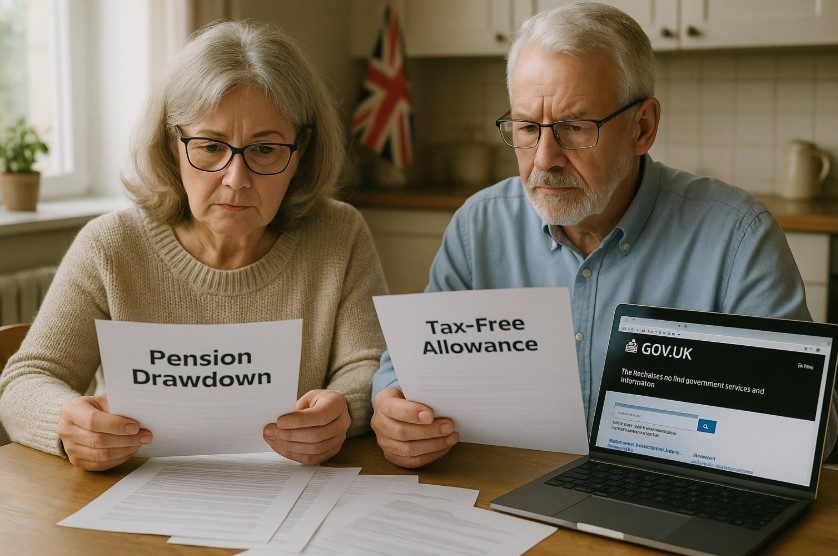Understanding how to legally reduce or avoid paying tax on your pension in the UK is essential for anyone approaching retirement or already drawing a pension.
With various rules and allowances governing pension income, it’s possible to make informed decisions that can significantly reduce your tax burden.
This guide outlines the key tax rules, strategies, and common pitfalls associated with pensions in the UK, helping individuals take advantage of available tax-free options.
What Are the Current UK Pension Tax Rules?

Pension income in the UK is treated as earned income and is therefore subject to Income Tax. The key factor is whether your total annual income, including pensions, exceeds your Personal Allowance, which is £12,570 for most people in the 2025/26 tax year.
If your total income remains below the Personal Allowance, you are not required to pay any Income Tax. However, once you exceed that threshold, pension income is taxed according to the applicable tax bands.
Tax is collected either through Pay As You Earn (PAYE) by your pension provider or through adjustments to your tax code by HMRC. In some cases, emergency tax may be applied when taking large withdrawals or when HMRC has not received updated income details.
Pensioners may also be affected by the loss of the Personal Allowance if their total income exceeds £100,000 annually. This reduces tax efficiency and may require more advanced tax planning.
How Much of Your Pension Can Be Taken Tax-Free?
Most people can take up to 25% of their total pension pot as a tax-free lump sum. This figure is capped at £268,275, regardless of the size of your pension savings. The tax-free amount does not impact your Personal Allowance, meaning you could still qualify for further tax-free income up to the £12,570 threshold.
Some individuals have what’s known as a protected tax-free cash entitlement. If this applies, you may be allowed to take more than 25% tax-free, depending on the specific rules of your pension scheme.
Here’s a simplified breakdown:
| Pension Value | Tax-Free Amount (25%) | Taxable Amount (Subject to Income Tax) |
|---|---|---|
| £60,000 | £15,000 | £45,000 |
| £100,000 | £25,000 | £75,000 |
| £1,000,000 | £250,000 | £750,000 |
Taking out the remaining pension beyond the 25% tax-free portion is considered income and taxed accordingly.
This may result in a higher tax bill if withdrawn all at once, particularly if the lump sum pushes you into a higher tax bracket in the same tax year.
What Is the Pension Personal Allowance and How Does It Work?
The Personal Allowance is the tax-free amount an individual can receive in income annually. For 2025/26, it is £12,570. Any pension income over that amount is taxed at:
- 20% (basic rate) on income between £12,571 and £50,270
- 40% (higher rate) on income between £50,271 and £125,140
- 45% (additional rate) on income above £125,140
Effective use of the Personal Allowance is key in reducing tax. A pensioner drawing less than £12,570 annually from all income sources will not pay any tax. Those who approach the higher tax thresholds may consider spreading withdrawals over several years to remain in the lower tax bands.
What Are the Ways to Reduce Tax on Your Pension?

Reducing the tax you pay on your pension income in the UK is achievable through a combination of smart financial planning, knowledge of HMRC rules, and structured pension withdrawal strategies.
While you may not be able to avoid tax entirely, there are several legitimate and government-approved methods that can significantly lower your overall liability.
1. Use the 25% Tax-Free Lump Sum Wisely
Most pension holders can withdraw 25% of their total pension pot tax-free, up to a maximum of £268,275. This lump sum can be taken in one go or in portions over time, depending on your pension scheme.
Key tip:
Avoid taking your entire pension lump sum in a single year unless necessary. Spread withdrawals to manage tax brackets efficiently.
2. Stay Within Your Personal Allowance
Every UK resident is entitled to a Personal Allowance of £12,570 per tax year. Keeping your total income, including pension withdrawals, within this limit ensures that you don’t pay any Income Tax.
Strategy examples:
- Draw only enough pension income to stay within your allowance
- Use other non-taxable sources like ISAs to supplement income
3. Spread Pension Withdrawals Over Several Years
Rather than withdrawing large amounts at once, you can use flexi-access drawdown to take smaller, regular amounts over time. This helps you avoid moving into higher tax bands unnecessarily.
Benefits:
- Helps stay in the basic rate tax band (20%)
- Allows part of each withdrawal to be tax-free (25% of each drawdown)
- Avoids triggering emergency tax
4. Use ISAs to Supplement Retirement Income
Withdrawals from Individual Savings Accounts (ISAs) are completely tax-free. By using ISAs alongside your pension, you can reduce the amount you need to withdraw from your taxable pension pots.
This strategy can help you:
- Limit taxable pension withdrawals
- Avoid breaching tax thresholds
- Maintain access to funds when needed without tax implications
5. Continue Pension Contributions to Gain Tax Relief
Even after retirement age, you can still receive tax relief on pension contributions if you’re earning. For those under the age of 75, contributions up to £60,000 per year are eligible for tax relief.
Additional Notes:
- Non-earners can contribute up to £3,600 annually and still receive tax relief
- Employer contributions and salary sacrifice schemes offer further tax efficiency
6. Make Use of Small Pension Pots
If you have personal or workplace pensions worth less than £10,000, you can take them as ‘small pot’ lump sums. You’re allowed to take up to three personal and unlimited workplace small pots.
Tax advantage:
- 25% of each small pot is tax-free
- The remaining 75% is taxed, but it may fall within your personal allowance, resulting in little or no tax
7. Avoid the Money Purchase Annual Allowance (MPAA) Where Possible
Accessing a pension flexibly may trigger the Money Purchase Annual Allowance, reducing your future tax-relieved contributions to just £10,000 per year.
To avoid triggering this:
- Consider taking only the tax-free lump sum without drawing taxable income
- Use other sources of income first, such as ISAs or part-time earnings
8. Time Pension Withdrawals Around Employment
If you’re transitioning into retirement and still working, be strategic with when you access your pension. Taking pension income in the same year as earning employment income could result in a higher overall tax bill.
Effective planning includes:
- Delaying pension drawdown until you reduce your working hours or stop completely
- Taking withdrawals in a low-income year to take advantage of unused Personal Allowance
9. Consider Gifting Surplus Pension Income
If you have more income than you need, you may be able to gift the surplus to reduce your taxable estate and potentially avoid Inheritance Tax. HMRC allows gifting of income without incurring tax if it’s done from regular surplus income and doesn’t affect your standard of living.
10. Seek Financial Advice for Tailored Planning
The best way to reduce tax on your pension is through a plan tailored to your personal financial situation. A regulated financial adviser can help you:
- Maximise tax efficiency across income sources
- Avoid breaching tax limits
- Plan for long-term pension sustainability and estate management
Summary of Legal Ways to Reduce Pension Tax:
| Strategy | Tax Benefit |
|---|---|
| 25% Tax-Free Lump Sum | No tax up to £268,275 |
| Flexi-Access Drawdown | Control taxable income and reduce tax band exposure |
| Use of ISAs | Provides tax-free supplementary income |
| Pension Contributions | Gain tax relief and reduce taxable income |
| Small Pension Pots | Multiple 25% tax-free withdrawals allowed |
| Income Gifting | Reduces taxable estate and potential Inheritance Tax |
| Timing Withdrawals | Aligns withdrawals with low-income years to avoid higher tax |
How Does the State Pension Affect Your Tax Situation?
The State Pension is also taxable but is paid without any tax deducted at source. If you receive other taxable pension income, HMRC adjusts your tax code to account for the State Pension when calculating tax owed on other sources.
In 2025/26, the full new State Pension is approximately £221.20 per week, or £11,502.40 per year. If this is your only income, it is under the Personal Allowance, and no tax will be due.
However, when the State Pension is combined with:
- A workplace pension
- A private pension
- Employment income
- Rental income
It can push your total annual income above the tax-free threshold. This might result in tax being collected through other pensions via an adjusted PAYE code.
Are There Legal Ways to Reduce Pension Tax Liability?

There are several lawful ways to manage and reduce your pension-related tax burden:
- Withdraw in stages: Smaller withdrawals may keep you in a lower tax band
- Utilise tax-free lump sums: Take the 25% portion strategically to support other income
- Supplement income with ISA savings: ISA withdrawals are tax-free and do not count towards income thresholds
- Gift excess income: If your pension income exceeds your needs and you meet HMRC gifting conditions, this could reduce your estate and future Inheritance Tax exposure
Some pensioners use ISAs or dividend income to supplement their pensions, as these often have their own allowances or tax exemptions, keeping total taxable income low.
What Role Does Your Overall Income Play in Pension Taxation?
Pension income is part of your total taxable income, which may include:
- Employment or self-employment income
- Rental property income
- Dividends and investment returns
- State benefits (where applicable)
When total income crosses tax band thresholds, higher tax rates apply. That’s why it’s essential to consider all income sources when drawing your pension.
Below is a table showing how total income impacts tax on pensions:
| Total Income Range | Tax Rate on Pension Income |
| £0 – £12,570 | 0% (Within Personal Allowance) |
| £12,571 – £50,270 | 20% (Basic Rate) |
| £50,271 – £125,140 | 40% (Higher Rate) |
| Over £125,140 | 45% (Additional Rate) |
Those with income near a tax band threshold should be cautious about the timing and size of pension withdrawals. Drawing a large pension sum in a single tax year could push you into a higher tax band unnecessarily.
Can Pension Contributions Still Offer Tax Relief?
Even after the age of 55, individuals may still contribute to pensions and benefit from tax relief. Contributions are eligible for tax relief at your marginal tax rate, subject to limits.
The Annual Allowance is set at £60,000 for 2025/26. This is the maximum amount you can contribute to pensions each tax year and still receive tax relief. Those with lower earnings will be limited to 100% of their income or £3,600 if non-earners.
Employers can also contribute to your pension, and these contributions are not considered part of your taxable income. Salary sacrifice schemes allow employees to reduce their taxable income by redirecting part of their salary into a pension scheme, which can result in tax and National Insurance savings.
If you access your pension flexibly (such as through income drawdown), your Money Purchase Annual Allowance (MPAA) may be triggered, reducing the contribution allowance to £10,000 annually.
How Tax Planning Reduces Pension Tax Liability with a Real-Life Example:
- A private pension pot worth £100,000
- No other income apart from his pension
- Wants to start drawing from his pension in the most tax-efficient way
David plans to take some income now but wants to avoid jumping into a higher tax band. His goal is to reduce or eliminate Income Tax on his withdrawals while maintaining flexibility.
David’s Strategy
- He takes £25,000 (25% of his pot) as a tax-free lump sum.
- For the rest, he decides to draw £12,000 per year via flexi-access drawdown.
- He uses an ISA to supplement income when needed, avoiding extra pension withdrawals.
- His total income stays within the £12,570 Personal Allowance, so no Income Tax is paid.
Table: David’s Pension Withdrawal Plan vs. High Lump Sum Withdrawal
| Action | Tax-Efficient Plan (David’s Approach) | One-Time Withdrawal (No Planning) |
|---|---|---|
| Total Pension Pot | £100,000 | £100,000 |
| 25% Tax-Free Lump Sum | £25,000 | £25,000 |
| Annual Drawdown | £12,000/year | £75,000 (lump sum in Year 1) |
| Taxable Income (Year 1) | £0 (below £12,570 threshold) | £75,000 – £12,570 = £62,430 taxed |
| Tax Band Exposure | None | 20% and 40% tax bands |
| Estimated Tax Paid (Year 1) | £0 | Approx. £17,000+ |
| Remaining Pension After Year 1 | £75,000 (untouched) | £0 (fully withdrawn) |
This example highlights the importance of controlled pension drawdown and tax band awareness. By managing withdrawals, David completely avoids Income Tax and keeps his pension pot invested for longer, potentially earning more value over time.
Should You Consider Professional Financial Advice for Tax Planning?

Pension tax planning can be complex, especially for those with multiple income sources or high-value pension pots. Financial advisers can help structure your income in a tax-efficient way, ensuring you:
- Stay within tax allowances
- Use drawdown options efficiently
- Manage estate planning effectively
- Avoid unintended tax charges on lump sums or death benefits
The cost of advice may be offset by tax savings over time, especially when navigating transitions into retirement or dealing with large pension pots subject to complex tax rules.
What Are the Common Mistakes That Lead to Higher Pension Tax?
Pensioners often make decisions that unintentionally increase their tax burden. These mistakes include:
- Taking their entire pension pot at once, pushing them into higher tax bands
- Not factoring in other income sources that affect tax bands
- Failing to notify HMRC of changes in income or tax code errors
- Triggering the MPAA unknowingly and restricting future contributions
- Not reviewing withdrawal strategies annually
Being aware of these pitfalls allows for more informed decisions and prevents unnecessary tax payments.
Conclusion
While it’s unlikely you can avoid pension tax entirely, understanding the system and making strategic decisions allows you to minimise tax exposure legally. Using the 25% tax-free lump sum wisely, staying within your Personal Allowance, drawing down gradually, and seeking advice where needed are all vital components of effective pension tax planning.
To avoid costly surprises in retirement, start planning early and remain aware of annual limits and allowances. With careful structuring, you can enjoy more of your hard-earned pension.
Frequently Asked Questions
What happens if my pension income exceeds the personal allowance?
You’ll pay Income Tax on any amount over the £12,570 threshold based on UK tax bands.
Can I avoid tax by withdrawing my pension after age 75?
No, withdrawing after 75 does not automatically avoid tax. In fact, tax rules may be stricter for death benefits past this age.
Do ISAs impact pension tax planning?
Yes, withdrawals from ISAs are tax-free and can help supplement income without affecting your tax band.
How many small pension pots can I take tax-free?
You can take up to 3 personal small pot lump sums (under £10,000) and unlimited workplace small pot lump sums, with 25% tax-free each.
Can I contribute to my pension and still get tax relief after 55?
Yes, as long as you meet contribution limits and have relevant earnings, tax relief is still available.
Is it better to take my pension in cash or as income?
It depends on your financial goals and tax situation. Income drawdown may offer more flexibility and tax efficiency.
Do I pay tax on a pension inherited from someone else?
It depends on their age at death and the structure of the pension. If they were under 75, it may be tax-free; if over 75, it is usually taxable.

Leave a Reply